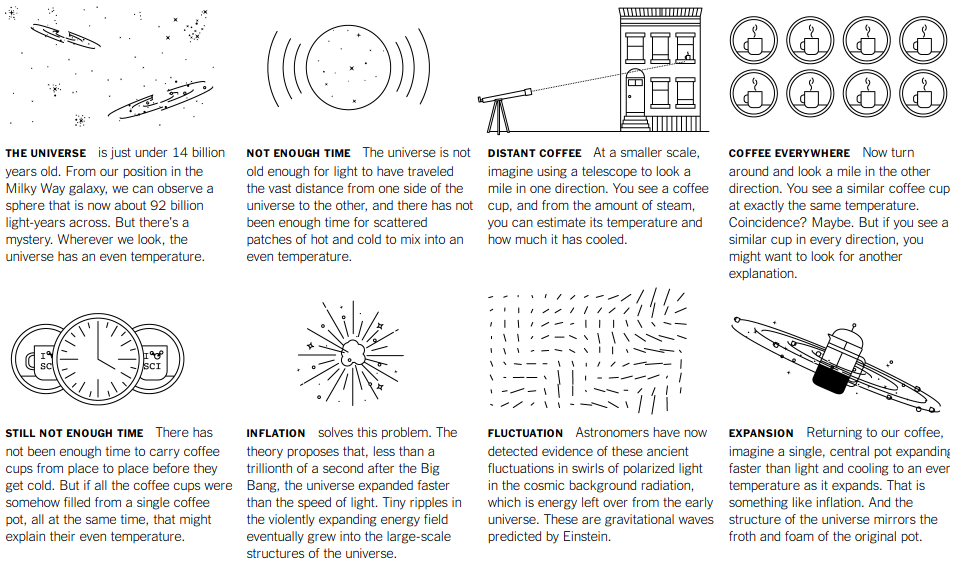Space Ripples Reveal Big Bang’s Smoking Gun

CAMBRIDGE, Mass. — One night late in 1979, an itinerant young physicist
He was trying to understand why there was no trace of some exotic particles that should have been created in the Big Bang. Instead he discovered what might have made the universe bang to begin with. A potential hitch in the presumed course of cosmic evolution could have infused space itself with a special energy that exerted a repulsive force, causing the universe to swell faster than the speed of light for a prodigiously violent instant.
If true, the rapid engorgement would solve paradoxes like why the heavens look uniform from pole to pole and not like a jagged, warped mess. The enormous ballooning would iron out all the wrinkles and irregularities. Those particles were not missing, but would be diluted beyond detection, like spit in the ocean.
“SPECTACULAR REALIZATION,” Dr. Guth wrote across the top of the page and drew a double box around it.
The Theory of Inflation
Astronomers have found evidence to support the theory of inflation, which explains how the universe expanded so uniformly and so quickly in the instant after the Big Bang 13.8 billion years ago.
By LARRY BUCHANAN and JONATHAN CORUM
“With nature, you have to be lucky,” he said. “Apparently we have been lucky.”
The results are the closely guarded distillation of three years’ worth of observations and analysis. Eschewing email for fear of a leak, Dr. Kovac personally delivered drafts of his work to a select few, meeting with Dr. Guth, who is now a professor at Massachusetts Institute of Technology (as is his son, Larry, who was sleeping that night in 1979), in his office last week.
“It was a very special moment, and one we took very seriously as scientists,” said Dr. Kovac, who chose his words as carefully as he tended his radio telescopes.
Andrei Linde of Stanford, a prolific theorist who first described the most popular variant of inflation, known as chaotic inflation, in 1983, was about to go on vacation in the Caribbean last week when Chao-Lin Kuo, a Stanford colleague and a member of Dr. Kovac’s team, knocked on his door with a bottle of Champagne to tell him the news.
Max Tegmark, a cosmologist at M.I.T., wrote in an email, “I think that if this stays true, it will go down as one of the greatest discoveries in the history of science.”
John E. Carlstrom of the University of Chicago, Dr. Kovac’s mentor and head of a competing project called the South Pole Telescope, pronounced himself deeply impressed. “I think the results are beautiful and very convincing,” he said.
Paul J. Steinhardt of Princeton, author of a competitor to inflation that posits the clash of a pair of universes as the cause of genesis, said that if true, the Bicep result would eliminate his model, but he expressed reservations about inflation.
Lawrence M. Krauss of Arizona State and others also emphasized the need for confirmation, noting that the new results exceeded earlier estimates based on temperature maps of the cosmic background by the European Space Agency’s Planck satellite and other assumptions about the universe.

In 2002, he was part of a team that discovered that the microwave radiation was polarized, meaning the light waves had a slight preference to vibrate in one direction rather than another.
This was a step toward the ultimate goal of detecting the gravitational waves from inflation. Such waves, squeezing space in one direction and stretching it in another as they go by, would twist the direction of polarization of the microwaves, theorists said. As a result, maps of the polarization in the sky should have little arrows going in spirals.
Detecting those spirals required measuring infinitesimally small differences in the temperature of the microwaves. The group’s telescope, Bicep2, is basically a giant superconducting thermometer.

 Gerald Rhemann
Gerald Rhemann
 NASA/JHUAPL
NASA/JHUAPL
 Peter Komka/EPA, via Shutterstock
Peter Komka/EPA, via Shutterstock
 NASA, ESA and D. Lin/University of New Hampshire
NASA, ESA and D. Lin/University of New Hampshire
 NASA
NASA
 NASA/GSFC/SDO
NASA/GSFC/SDO
 Brian Rea
Brian Rea
 .
.
 Andre Liohn/European Pressphoto Agency
Andre Liohn/European Pressphoto Agency